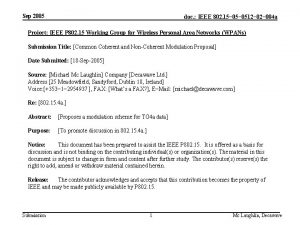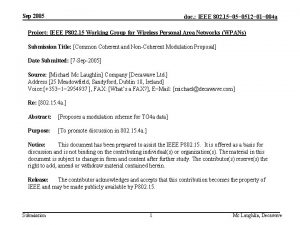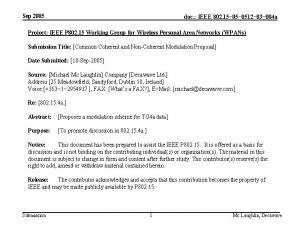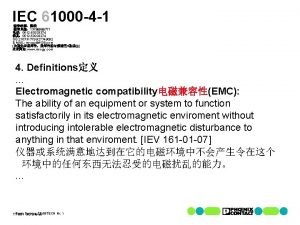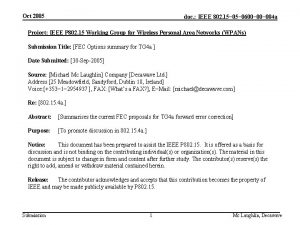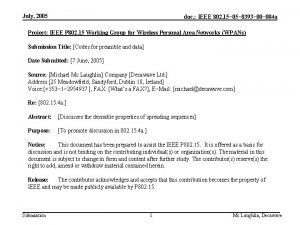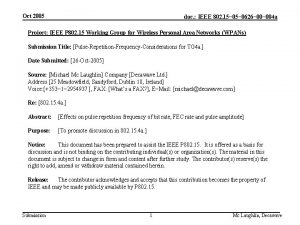Sep 2005 doc IEEE 802 15 0512 004









- Slides: 9

Sep 2005 doc. : IEEE 802. 15− 0512− 004 a Project: IEEE P 802. 15 Working Group for Wireless Personal Area Networks (WPANs) Submission Title: [Common Coherent and Non-Coherent Modulation Proposal] Date Submitted: [7 -Sep-2005] Source: [Michael Mc Laughlin] Company [Decawave Ltd. ] Address [25 Meadowfield, Sandyford, Dublin 18, Ireland] Voice: [+353− 1− 2954937 ], FAX: [What’s a FAX? ], E−Mail: [michael@decawave. com] Re: [802. 15. 4 a. ] Abstract: [Proposes a modulation scheme for TG 4 a data] Purpose: [To promote discussion in 802. 15. 4 a. ] Notice: This document has been prepared to assist the IEEE P 802. 15. It is offered as a basis for discussion and is not binding on the contributing individual(s) or organization(s). The material in this document is subject to change in form and content after further study. The contributor(s) reserve(s) the right to add, amend or withdraw material contained herein. Release: The contributor acknowledges and accepts that this contribution becomes the property of IEEE and may be made publicly available by P 802. 15. Submission 1 Mc Laughlin, Decawave

Sep 2005 doc. : IEEE 802. 15− 0512− 004 a Modulation Proposal: Option X (or the new III? ) A common coherent and non-coherent modulation scheme for use with all PRFs. Submission 2 Mc Laughlin, Decawave

Sep 2005 doc. : IEEE 802. 15− 0512− 004 a Trellis Diagram, Optimum antipodal conv. code with g 1=35, g 2=23 dfree = 7, 2 parallel pathways Submission 3 Mc Laughlin, Decawave

Sep 2005 doc. : IEEE 802. 15− 0512− 004 a Trellis Diagram, Non-Antipodal g 1=35, g 2=23 dfree = 5, 1 pathway Submission 4 Mc Laughlin, Decawave

Sep 2005 doc. : IEEE 802. 15− 0512− 004 a Trellis Diagram, Non-Antipodal g 1=35, g 2=16 Submission 5 Mc Laughlin, Decawave

Sep 2005 doc. : IEEE 802. 15− 0512− 004 a Trellis Diagram, Non-Antipodal g 1=33, g 2=02 Submission 6 Mc Laughlin, Decawave

Sep 2005 doc. : IEEE 802. 15− 0512− 004 a AWGN PER with k=5 for various polynomial generators Seems as if (35, 16) has slight advantage but the systematic code (33, 02) makes things easier all round Submission 7 Mc Laughlin, Decawave

Sep 2005 doc. : IEEE 802. 15− 0512− 004 a Proposed Option X XOR Pos’n Sign Symbol Transmitted 0 0 -1. . 1 0. . 0 0 1 1. . -1 0. . 0 1 0 0. . 0 -1. . 1 1 1 0. . 0 1. . -1 data in Sign Pos’n Coded data out Note: Can recover Pos’n bit with non-coherent receiver architecture. Exact code composition TBD Submission Figure 7. Convolutional code. Rate ½ code, K=5, Generators (33, 02), g 1=11011, g 2=00010 8 Mc Laughlin, Decawave

Sep 2005 doc. : IEEE 802. 15− 0512− 004 a Conclusion • 2 Recommendations – Use the same combined PPM and BPSK for both coherent and non-coherent modulation at all PRFs. – Use K=5 convolutional code with octal generators (33, 02) for sign and position respectively Submission 9 Mc Laughlin, Decawave










